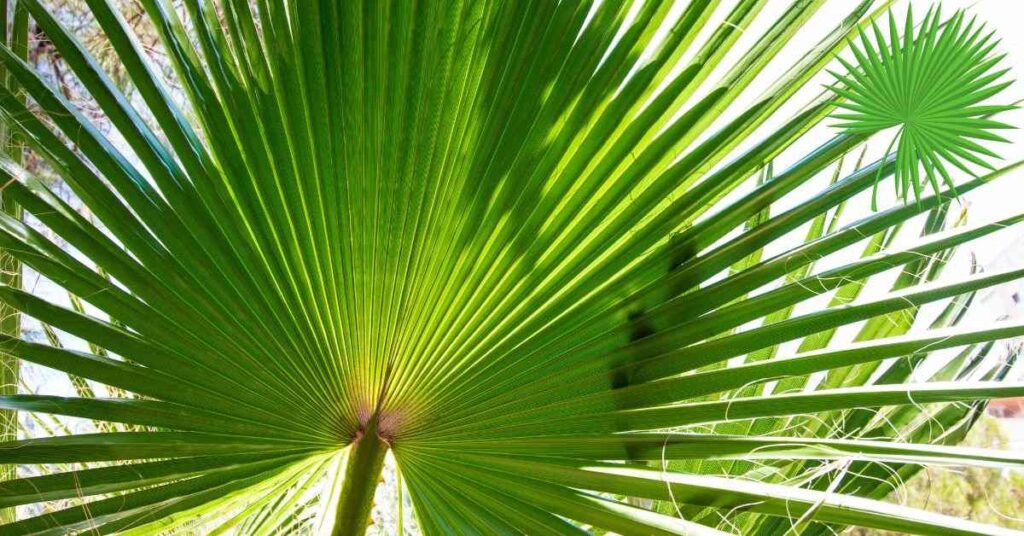There are many stories told about trees, but these 16 facts about the palm tree leaves make the palm species a unique tree standing out from other trees. The uses and benefits of palms have proven the usefulness of every part, from the leaves to the trunk and root.
There is more to palm trees than their uses; come with me as I take you through different facts about palm tree leaves.
Let’s get started.
Variety of Palm Tree Leaves
Nature’s creativity endeared us to the exciting facts behind the diverse range of palm leaf varieties, which come in an astonishing array of leaf shapes and sizes. Each leaf tells a unique story of adaptation and beauty.
1. Feather-Like Fronds
Feather-Like Fronds feature slender leaflets that radiate from a central stalk, resembling the wings of a butterfly in flight. The areca palm (Dypsis lutescens), also known as the butterfly palm, is famous for its graceful, feather-like fronds. These delicate leaves native to Madagascar’s Areca palm’s feathery foliage add a touch of tropical elegance to indoor and outdoor spaces alike.
2. Majestic Fan-Shaped Foliage

Have you ever seen a circular manual hand fan? If you answered in the affirmative, then you might have as well seen a variety of palm leaves like the windmill palm in this shape. Originating from East Asia, this cold-hardy palm species showcases large, palmate leaves that fan outwards in a circular pattern.
The Windmill Palm (Trachycarpus fortunei) takes center stage with its striking fan-shaped leaves. With its architectural beauty and resilience to frost, the windmill palm is a favorite choice for landscaping in temperate regions.
3. Exotic Bifid Leaves
The palm tree variety with bifid leaves is the Bismarck palm (Bismarckia nobilis). It has big, bifid leaves that look like big fans that make it stand out. This beautiful palm species comes from Madagascar. It has big, blue-green leaves with highly divided segments that make it look stunning. The Bismarck palm gives tropical and subtropical settings a touch of exotic grandeur with its tall height and unique fronds.
4. Architectural Pinnate Palms
Pinnate palms, characterized by their feather-like leaves arranged along a central stalk, offer a diverse range of architectural forms. From the towering Royal Palm (Roystonea spp.) with its elegant, arching fronds to the compact Pygmy Date Palm (Phoenix roebelenii) with its gracefully drooping foliage, pinnate palm varieties showcase a wide spectrum of shapes and sizes. Whether adorning avenues, parks, or botanical gardens, these majestic palms never fail to captivate with their regal presence.
5. Variegated Beauties of Palm Tree Leaves
Some palm species exhibit variegated foliage, featuring striking patterns of contrasting colors such as green, yellow, and white. The variegated rhapis palm (Rhapis excelsa) is a prime example, boasting intricately patterned leaves that add a vibrant splash of color to indoor and outdoor settings. With its compact growth habit and eye-catching foliage, the variegated rhapis palm is a popular choice for adding visual interest to gardens and interior spaces.
Adaptability of Palm Tree Leaves
Palm tree leaves are not just exquisite in appearance; they are also marvels of adaptability, perfectly suited to thrive in a variety of environments. Step into the enchanting world of palm trees, where resilience meets beauty in the form of their extraordinary leaves.
6. Flexible Leaf Structures
Palm tree leaves are renowned for their flexibility, allowing them to sway gracefully in the breeze without snapping or breaking. The fibrous texture of palm leaves, which are made up of strong and resilient fibers, is responsible for this distinctive quality. Whether facing strong winds in coastal areas or gentle breezes in tropical gardens, palm leaves effortlessly adapt to their surroundings, ensuring their survival in diverse environments.
7. Drought Tolerance
One of the most remarkable aspects of palm tree leaves is their ability to withstand drought conditions. Many palm species have evolved adaptations such as waxy coatings and sunken stomata (small pores on the leaf surface) to minimize water loss through transpiration.
8. Sunlight Regulation
Each time I admired my coconut tree in the backyard, I used to wonder how those leaves could withstand the heat of the sun. Palm tree leaves have evolved various mechanisms to regulate sunlight absorption and minimize heat stress.
In tropical climates where sunlight intensity is high, palm leaves often feature adaptations such as narrow leaflets or reflective surfaces to reduce solar radiation. This helps prevent overheating and dehydration, allowing palm trees to flourish even in sun-drenched landscapes.
9. Salt Tolerance
Coastal palm species have developed specialized adaptations to tolerate high levels of salt in the air and soil. Their leaves are equipped with salt-excreting glands that filter out excess salt, preventing damage to the plant’s tissues. In addition, some palms, such as the coconut palm (Cocos nucifera), can excrete salt through their fronds, creating a protective barrier against salt spray and soil salinity.
10. Versatility in Landscaping
The adaptability of palm tree leaves extends beyond their natural habitats to urban landscapes and gardens. Because of their versatility, palm trees are a popular choice for many settings, from tropical resorts and beach promenades to urban streets and desert oases. All throughout the world, people are choosing them for landscaping because of the exotic allure they bring with their luxuriant leaves and exquisite shapes.
11. The Fascinating Growth Journey of Palm Tree Leaves
Anytime I am on palm tree exploration, my goal is to catch a glimpse of the young, sprouting leaves of the oil palm tree. What captivates me most is the light green color and how these new leaves emerged from their fold. Unraveling the mysteries behind these phenomena helps us gain insight into how palm leaves form the bud.
12. Emergence from the Bud
The journey of a palm leaf begins with a moment of emergence from the protective embrace of the bud. As the bud unfurls, delicate leaflets gradually unfold, revealing the promise of new growth. This initial stage is a testament to nature’s precision and beauty, marking the beginning of a leaf’s journey toward maturity.
13. Gradual Unfurling
Once emerged, palm leaves undergo a gradual process of unfurling, where each leaflet unfolds in a synchronized dance of expansion. This slow and deliberate unfolding allows the leaf to adjust to its surroundings and optimize its position for maximum sunlight absorption. As the leaf unfurls, its intricate structure becomes increasingly evident, showcasing nature’s meticulous craftsmanship.
14. Expansion and Maturation
With each passing day, palm leaves continue to expand and mature, reaching their full potential in both size and functionality. During this stage, the leaf undergoes significant structural development, with the central rib strengthening and the leaflets reaching their final form. As the leaf matures, it becomes an integral part of the palm tree’s canopy, contributing to its overall health and vitality.
15. Role in Photosynthesis
As fully developed organs of photosynthesis, palm leaves play a crucial role in the tree’s ability to harness sunlight and convert it into energy. Through the process of photosynthesis, leaves absorb carbon dioxide from the air and water from the soil, using sunlight to synthesize sugars and release oxygen as a byproduct. This intricate biochemical process sustains life not only for the palm tree but also for countless other organisms within its ecosystem.
16. Continuous Renewal
The growth journey of palm tree leaves is a continuous cycle of renewal, with new leaves emerging to replace those that have completed their lifecycle. This ongoing process ensures the perpetuation of growth and vitality within the palm tree canopy, maintaining its lush greenery and vibrant presence year-round.
Final thought
Now that you are aware of the 16 facts about palm tree leaves, you can fully appreciate the natural gift of this unique tree species. You can strategically consider incorporating them into your landscape or front yard garden, or use them for other purposes.
From the delicate emergence of a bud to the imposing maturity of a fully developed leaf, each stage of growth reflects the beauty and resilience of palm trees.
Armed with all these gems about palm tree leaves, let’s go to a nearby tree nursery home to pick some seedlings, plant them, and marvel at the captivating journey of palm leaf growth, gaining a deeper appreciation for the wonders of the natural world.

